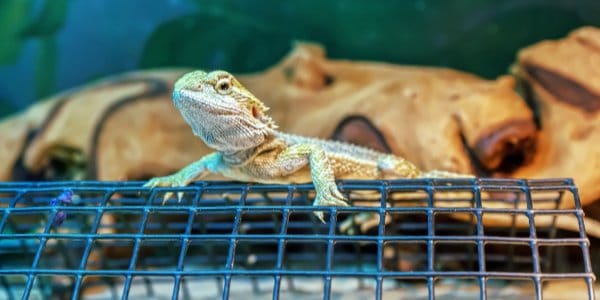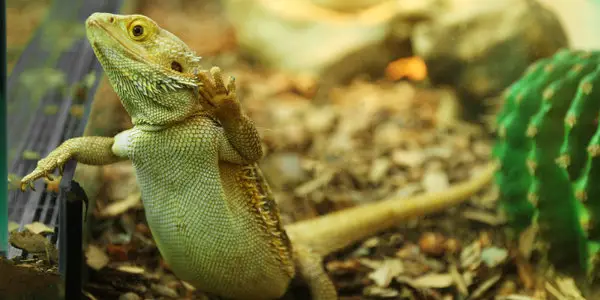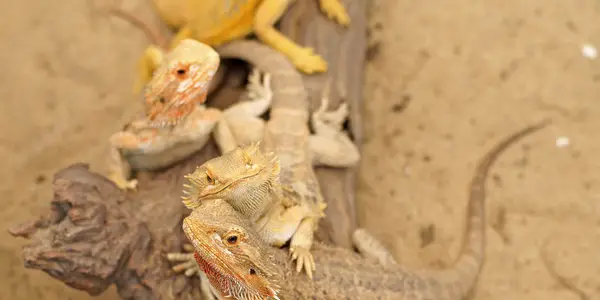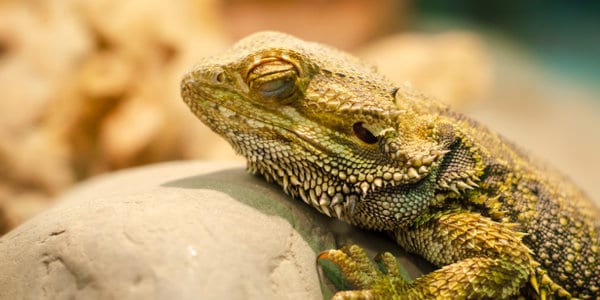If you’re enthusiastic or experienced in bearded dragon pet care, it’s easy to study and understand your beardie’s daily routine. On the other hand, inexperienced bearded dragon owner might find it harder to understand their unique pet. Either way, finding a bearded dragon that’s normally active curled up or sleeping in a corner is cause for concern.
So, why do bearded dragons sleep in the corner? Sometimes a beardie pet sleeps in the corner of their enclosure as part of their normal response to an unfamiliar artificial habitat especially if you just relocated them to a new tank. In such cases, your pet is still adapting to the new surroundings and they may have found the corner cozier for slumbering than the other spots.
Then again, your bearded dragon could be sleeping in the corner in an attempt to hide from unfavorable tank conditions such as temperature extremes, imbalanced humidity, insufficient space, unsuitable lighting arrangements and cycles, deficient UVB radiation, inadequate hiding spots, or presence of other pets or creatures in the tank.
Moreover, captive beardies sometimes sleep in their tank’s corner during the brumation season (winter) or due to stress or lethargy occasioned by health complications such as parasites, dehydration, impaction, and illnesses.
Whatever reason your pet has for sleeping in the corner of their cage, it’s crucial to identify the specific reason. If you haven’t recently transferred your dragon to a new tank and they were previously active and sleeping normally, there’s a high chance that something is awfully wrong with your beloved pet or their habitat.
Read on as we dive deeper into the reasons for pet bearded dragons sleeping in their tank’s corner consistently. Additionally, we’ll highlight what measures to take towards resolve each issue causing your beardie to slumber in the corner.
Let’s dive right in:
Why is My Bearded Dragon Sleeping in The Corner?
If you notice that your pet bearded dragon is consistently sleeping in their cage’s corner, you can chalk it out to any of the following reasons:
1. They’re New to the Tank
When you adapt a baby bearded dragon or relocate an elder beardie to a new tank, they experience relocation stress for a few hours or days. Before the pet adjusts to their new habitat completely, they tend to eat less, play little, explore less, and sleep a lot more than normal.
On top of this, your dragon is likely to sleep a lot in their tank’s corner as they may have not explored the enclosure enough to discover other cozier sleeping spots.
If this is the case with your beardie pet, there’s little you can do but give them sufficient time to acclimatize themselves to their new habitat.
Nevertheless, there are a few measures you can take to help your bearded dragon to ease into their new home faster and easier.
Ensure their tank is comfortable setup with all requisite conditions set at their optimum levels to keep the dragon healthy, comfortable, and happy. Further, limit the frequency and time of handling the lizard until they’re comfortably settled.
Furthermore, a bearded dragon sometimes prefers to sleep in the corner when shedding as it might be more comfortable there. At such times, the dragon wants nothing more than to be left alone, and choosing to sleep in a corner for seclusion is only natural.
Unfavorable Tank Conditions
Out in the wild, bearded dragons thrive in the arid Australian desert, woodlands, and outback. This locale receives plenty of sunshine during the day and has cooler nights.
Along with this, the natural bearded dragon habitat contains plenty of low trees, rocks, small caves, and burrows for beardies to explore, bask on, hide in, and sleep.
Like their wild friends, captive bearded dragons require similar living conditions in their artificial habitat to not only survive but enjoy an active, happy, healthy, and full life. That’s why you must replicate a beardie’s natural habitat in their artificial one to enable the dragon to thrive.
However, bearded dragon tanks often fall short on one or more of the recommended conditions for a caged beardie. When this happens, your pet suffers a lot of discomfort or pain and often resorts to sleeping in their tank’s corner to ease the irritation and stress.
You must be wondering what tank conditions are unsuitable for a pet bearded dragon. Let’s review the most common tank irregularities that force beardies to sleep in their cage’s corner:
2. Extreme Tank Temperature Levels
Like other cold-blooded animals, beardies rely on the temperatures of their surroundings to regulate their body temperature and perform most body functions including digestion and nutrient absorption among others.
If the temperatures inside the tank rise and stay beyond the recommended readings, your bearded dragon might overheat, get dehydrated, and die. To prevent this, a beardie opts to sneak inside a hiding spot, burrow under the substrate, or shift to the cool area of their tank to cool off.
Thus, if your beardie’s tank lacks the requisite cooling spot or sufficient hides, the dragon has limited options left. They can either burrow and hide under the substrate or sleep in a corner in their tank that’s often cooler than the other parts of the tank.
On the other hand, extremely low tank temperatures can freeze over a bearded dragon to the point of death. The only way to prevent this is ensuring your pet’s tank always has the recommended tank temperature readings at the basking, general, and cooling spots respectively.
This way, your dragon can move from the basking, warm, or cooling spots accordingly to regulate their body temperature.
Fortunately, maintaining the recommended temperature gradient in a bearded dragon’s tank is relatively easy. All you need is a thermostat and reliable digital thermometer to adjust and monitor the temperatures respectively.
Typically, you should maintain the beardie’s basking area at 95-110°F while keeping the general and cooling spots at 80-85°F and 70-75°F correspondingly.
Possibly the worst thing about leaving the tank temperatures to spiral out of control is that your pet might be unable to regulate their body temperatures accordingly henceforth.
As a result, most of their body functions may flop or proceed inappropriately. This not only stresses out a beardie but also weakens them substantially and eventually causes the pet’s premature death.

3. Inappropriate Lighting Arrangements or Cycles
Since bearded dragons are diurnal, they naturally stay awake and active during the day and go to sleep after sunset (when darkness set in). This sleep-wake cycle, along with the beardie’s circadian rhythm, influences many body and mind functions such as digestion, bone development, and the functioning of the reptile’s cardiovascular and immune systems.
Thus, if you want your beardie pet to thrive, it’s essential that you mimic the dragon’s natural habitat conditions in their artificial habitat.
Poor lighting conditions disrupt a beardie’s biological clock, thereby interrupt their regular schedule and could lead your pet to sleep excessively during the day or in their tank’s corner.
Leaving the tank lights on at night or flooding the entire enclosure with light make a beardie to sleep in the corner of their tank. In such instances, the light irritates the pet, so they escape to a corner that’s normally darker than the rest of the enclosure.
You don’t want to miss this: Persistent poor lighting in a beardie’s tank leads to a host of health complications such as eye damage, lethargy, appetite loss, and general weakness.
Luckily you can resolve this issue by correctly installing suitable tank lights to light up the tank during the day.
Further, stick to a regular lighting schedule similar to the beardie’s natural day-night cycle to ensure the pet enjoys sufficient lighting during the day and sleep (rest) at night.
But that’s not all. If your beardie pet is sleeping in the corner because the tank lights irritate them at night, consider installing an under-tank heat mat or ceramic heat emitter.
These appliances reliably warm up the bearded dragon’s enclosure at night without supplying any light that disturbs the beardie.
4. Insufficient UVB Radiation
In their natural habitat in the wild, bearded dragons enjoy basking in the sun for relaxation and vitamin D3 uptake. Similarly, your captive beardie requires sufficient UVB radiation to synthesize vitamin D3 which in turn fosters effective calcium absorption.
Unfortunately, a caged dragon can’ receive sufficient ultraviolet-B (UVB) from natural sunlight because it’s either blocked, reflected away, or deflected by the terrarium walls and other objects before reaching the lizard. Therefore, you have to supplement the natural sunlight with artificial full-spectrum light.
Bear in mind that consistent inadequate UVB radiation inhibits effective vitamin D3 synthesis. As a result, your beardie pet can’t metabolize calcium and other valuable nutrients effectively.
In turn, this causes a plethora of health snags to bearded dragons such as blindness, eye damage, uncontrolled shedding, and Metabolic Bone Disease (MBD).
Luckily, settling this issue is straightforward- just invest in the right UVB light for your reptile pet. On top of this, stick to the recommended daily UVB lighting schedule of 12-14 hours during the hot seasons and 8-10 hours during the cold seasons. Remember to switch off the UVB lights at night.
5. Deficient Tank Space
Bearded dragons grow up pretty fast. Within 12 months, a healthy baby beardie swiftly transitions into the juvenile stage through to an adult bearded dragon. As the pets grow, their space requirements increase in-step.
Thus, you need to acquire a beardie tank with sufficient to space to house your pet, their furniture, food, and hiding spots comfortably. In case the space is limiting, your dragon might opt to sleep in the corner where it’s less crowded, cooler, and cozier.
Do you want your bearded dragon companion to grow up healthy, happy, and active? Ensure they have sufficient tank space to feed, play, explore, bask, and sleep.
Typically, a baby bearded dragon should stay in a tank with at least 40-gallon capacity while it’s recommended to keep their adult counterparts in at least 60-gallon tank.

6. Inadequate Hiding Spots
The natural bearded dragon habitat in the wild consists of numerous places such as caves, low-lying branches, shallow burrows, and caverns where bearded dragons habitually scamper into to escape the onslaught of harsh environmental conditions or predators. This should mirror in an ideal artificial bearded dragon tank.
Sadly, many inexperienced bearded dragon owners overlook the importance of hiding spots to a beardie pet.
If your pet doesn’t have sufficient and appropriately placed spots to hide from excess heat, scary sights, or unfamiliar sounds, they might get overly agitated or stressed out.
As a result, the pet withdraws to the corner where they hide and sleep or resorts to burrow under the substrate.
Possibly one of the most important considerations when keeping a beardie as a pet is to ensure that their tank has at least two hiding spots.
This allows the dragon to hide from scary and potentially harmful situations such as extremely high temperatures and unsuitable lighting.
7. Presence of Other Pets or Creatures Inside or Near the Beardie’s Tank
Naturally, bearded dragons are solitary creatures and territorial reptiles. Unlike social animals that live in groups, beardies love living and thrive when living alone.
Whenever male or female beardies encounter each other, they’re likely to get aggressive as they complete for dominance over territory, mates, food, and other resources.
If you have two bearded dragons in the same tank that can be the reason why your pet is sleeping on the corner.
While the dominant beardie enjoys most of the tank space and other resources, the weaker beardie is left oppressed for space, food, and space.
Consequently, the weaker dragon is likely to hide and sleep in the enclosure’s corner to avoid agitating the domineering lizard.
And that’s not the end of it. Bearded dragons interpret other creatures as either potential predators or other forms of threat especially if the creatures are larger than the dragon.
However, even smaller creatures such as uneaten roaches can also stress out, bite, or injure your beardie. Consequently, the dragon is likely to retreat to the corner of the tank where they sleep in fright.
Unfortunately, the only way to save your bearded dragon friend from this torture is by housing each of them separately. This way, each of your beardies gets to enjoy sufficient tank space, food, hides, and other resources without competing with their friends.
Beyond this, ensure your beardie’s tank is away from a window or other place where the beardie can easily perceive other bearded dragons, pets, or other animals (even humans). This seclusion saves your pet from a lot of undue agitation, stress, and sleeping in the corner of their tank.
Then again you can install appropriate background around your beardie’s terrarium to seep out external disturbing sights from reaching the beardie.
Bear in mind that a beardie naturally interprets their reflection on the tank walls as another bearded dragon and reacts the same way they would if it was a real beardie.
8. Loud Noise and Unfamiliar Sights
Bearded dragons cherish their peace and seclusion. Therefore, any loud noises or unfamiliar sights around their terrarium agitate and stress out the lizards to the point of scampering under their hides or sleeping in the corner of their cage.
The only way to prevent disturbing sights and noises from stressing out your pet and causing them to sleep in the corner is to ensure the dragon’s terrarium is appropriately set away from such occurrences.
Health Complications
Your bearded dragon could be consistently sleeping in the corner of their cage due to a number of health problems that are painful, uncomfortable, or stressing to the pet.
Typically, the dragon hides in the corner until the situation eases. Beardie health snags that result in beardies sleeping in the corner include:
9. Stress
While stress in beardies can result from numerous different sources, the most common cause is unsuitable tank conditions such as deficient UVB radiation, inappropriate lighting, unsuitable temperatures, and imbalanced humidity levels.
On top of this, a bearded dragon can be stressed out by other factors outside their tank such as extraneous lights at night, loud noises, and unfamiliar or scary sights around the terrarium.
Luckily, stress is easy to treat by resolving the underlying issue. If inappropriate tank conditions are the cause, fix the specific issue to drive out the stress and guarantee your beardie friend an all-round healthy, active, and enjoyable full life.

10. Metabolic Bone Disease (MBD)
Metabolic bone disease is fatal to beardies if it’s not treated promptly. It’s caused by either a calcium-deficient diet or insufficient exposure to UVB radiation.
We’ve already established that bearded dragons derive vitamin D3 from UVB light to absorb essential minerals like calcium.
Typically, MBD is characterized by appetite loss, general body weakness, lethargy, and swelling of the jaw and hind legs in bearded dragons.
Fortunately, MBD is curable in most instances as long as you discover it early. Otherwise, a beardie pet with metabolic bone disease is best treated by a reliable reptile pet vet.
11. Dehydration
A dehydrated bearded dragon displays a number of weird traits such as lethargy, sleeping excessive, refusing to eat, general inactivity, and sleeping in their tank’s corner. In all these cases, your pet is simply trying to conserve the water in their body for survival.
Luckily, dehydration in beardies is relatively easy to prevent or resolve. Here are a few measures to drive out dehydration in captive bearded dragons:
- Keep a bowl with clean water in the beardie tank at all times and ensure you place it conveniently so that your lizard can find it effortlessly
- Feed your beardie with fresh fruits, leafy greens, and veggies with ample water content to keep them properly hydrated. Don’t forget to observe the recommended dietary composition of approximately 70% plant matter and 30% animal protein for adult bearded dragons along with roughly 30% plant compositing and 70% animal protein for baby bearded dragons
- Give your beardie pet frequent baths in warm water and occasional massages. It’s also okay to allow the dragon to swim in a shallow pool under your strict supervision.
12. Respiratory Infections
Oftentimes, respiratory infections in beardies are caused by extremely low tank temperatures, unhygienic tank conditions, lack of crucial elements in the pet’s diet, or extreme stress levels. These illnesses are commonly characterized by relentless sneezing, labored breathing, and undue lethargy along with runny eyes and nose in a bearded dragon.
Luckily, you only need to resolve the underlying issue and provide suitable tank conditions to prevent respiratory infections in a pet bearded dragon. Nevertheless, you need to take your pet to a vet if you suspect they’ve contracted a respiratory infection.
13. Impaction
When a beardie ingests food that’s too large for their gut, eats inappropriate foods such as grains, or swallows inedible substrate material such as sawdust, sand, or wood chippings, impaction might set in alongside other ugly consequences like physical injury to the digestive system.
On top of that, you might discover that the pet turns extremely lethargic, their hind limps become immobile, and the lizard consistently sleeps at the same spot such as their cage’s corner.
Fortunately, you can prevent impaction by providing suitable substrate material. Beyond this, always feed your pet with foodstuffs whose size doesn’t exceed the distance between the lizard’s two primary eyes to ensure the food passes through the entire gut system naturally without hardship.
14. Adenovirus
Adenovirus is an extremely deadly beardie disease that causes paralysis, excessive weakness and lethargy, and food rejection before sending your beloved pet to their grave prematurely. On top of this, your beardie might sleep in the corner of their enclosure.
Sadly, Adenovirus is incurable. The best chance you have of saving a beardie ailing from this condition is housing them separately and treating them to alleviate the symptoms.
15. Parasites
Parasites are organisms that live on or inside a beardie’s body and feed off the lizard’s nutrition without offering any benefit in return. External beardie pests burrow into and live under a beardie’s skin and include mites and ticks while pinworms and other internal-body parasites reside in the dragon’s digestive system.
Oftentimes, parasitic attacks on a bearded dragon pet causes malnutrition, diarrhea, lethargy, weight loss, and could even make your bearded dragon to sleep in their cage’s corner. Eventually, most parasitic attacks lead to the death of your pet before their time if left untreated for long.
As luck would have it, parasites are easy to control by keeping the bearded dragon’s tank hygienic, housing your beardie pets separately, giving your bearded dragons warm bath and massages, and observing them for any signs of parasites.
On top of this, seeking prompt reptile vet intervention once you discover that your beardie is infested with parasites is probably the most human step you can take.

Why Do Bearded Dragons Sleep in One Spot?
In most instances, bearded dragons sleep in one spot when they’re lethargic or stressed out. Then again, your pet could simply be lazy or worn out after a busy day of playing, feeding, and exploring, so they doesn’t want to walk to or have no energy to shift to another spot to slumber.
Still, it’s important to check out your beardie pet’s habitat and monitor the reptile to ensure no serious underlying issue is causing them to sleep in one spot repeatedly.
Why Do Beardies Sleep in Awkward Positions?
Typically, pet bearded dragons often sleep lying on their stomach as the position is both easy and comfy. However, these pets are fascinating in many ways, and their sleeping habits are proof of this fact.
For instance, you might find your bearded dragon is sleeping upright against the terrarium wall as they often do on trees in their natural habitats.
Mostly, beardies sleep in strange positions to get the right amount of sleep comfortably. Besides queer sleeping positions, the dragons have numerous other unique sleeping habits that include:
- Burrowing under the substrate while sleeping to escape unfavorable conditions like disturbing lights or another beardie in the same tank.
- Changing their skin color to a lighter shade when asleep due to their circadian rhythms.
- Sleeping excessively for days or weeks on stretch during brumation in the cold months.
- Slowing down their breathing rate to a barely perceptible state to slow their respiratory and metabolic processes and save up their energy reserves for more vigorous activities like playing and exploration.
Final Words
A pet bearded dragon sleeps in the corner of their enclosure for a variety of reasons. If you’ve recently relocated the pet from another tank to a new enclosure or have just adopted a baby beardie from the breeder, they could still be adjusting to their new artificial habitat.
If that’s the case, the best you can do is to help you precious beardie attune to the unfamiliar place is make their tank as hygienic as possible, maintain optimal conditions in and around their tank, feed them a healthy and sufficient diet, and limit handling them until they’re properly settled in their new space.
On the other hand, your pet beardie could be consistently sleeping in the corner of their enclosure due to extreme stress or lethargy levels.
Oftentimes, unfavorable terrarium conditions such as inappropriate lighting, unsuitable temperatures, insufficient space, and inadequate hiding spots stress out a beardie to the point of causing them to sleep in the corner.
In such instances, resolving the underlying issue is usually the only way to return your pet to their normal sleeping habits.
Then again, your bearded friend might be sleeping in the corner in response to natural beardie processes like brumation or shedding.
If this is the case, do the best to help your pet go through these natural processes smoothly by keeping them comfortable and offering warm periodic baths respectively.
If a health condition is responsible for driving your bearded dragon to sleep in the corner, do your best to make the pet comfortable and resolve the underlying issue.
After that, seek prompt medical advice and assistance from a dependable reptile pet veterinarian to save your precious beardie from the undue pain and discomfort, restore their regular sleeping habits, and keep them happy and active.